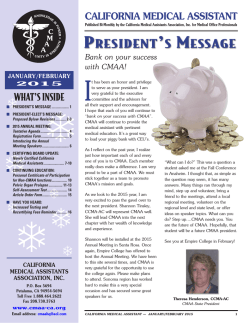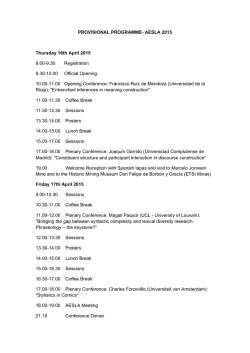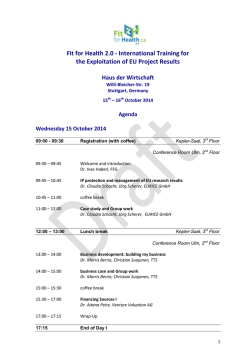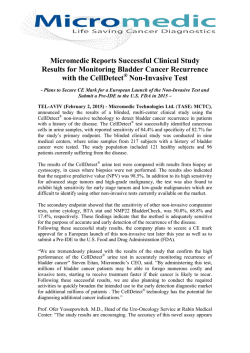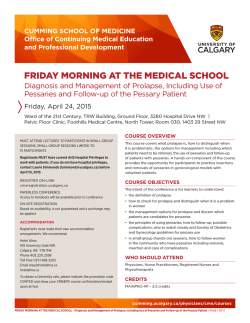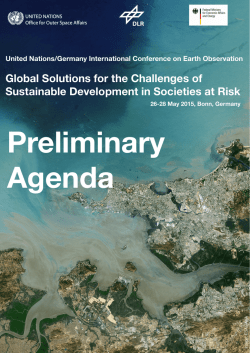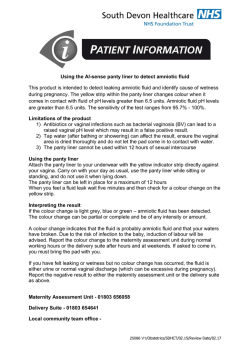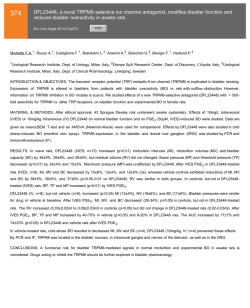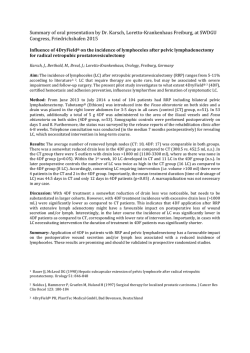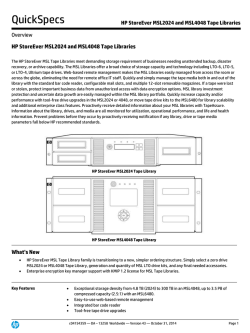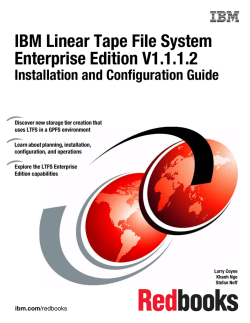
NUGA 14 - 16 May 2009 Sponsorship Opportunities
PROGRAMME THURSDAY Jan 29, 2015 1800-1945 Workshop urodynamics, Gunnar Lose and Niels Klarskov FRIDAY Jan 30, 2015 0845-0900 0900-0945 Welcome, Corinne Pedroletti, Yngvild Skåtun Hannestad 0900-0930 Botulinum Toxin for the treatment of Overactive Bladder: Clinical Data and Practical Application Victor Nitti, Professor of Urology and Ob/Gyn, NYU Langone Medical Center, USA 0930-0945 Discussion 0945-1015 Coffee Break 1015-1115 Poster session (5 posters, 5+5 min) Chair: Mette Hornum Bing OP1 Clinical efficacy and safety of mirabegron treatment for overactive bladder Anna Almen Christiansson, SE OP2 Intravesical Botox® injections for overactive bladder in an outpatient setting: clinical short term results Caroline Elmér, SE OP3 Prevalence of Mycoplasmataceae bacteria in women with urethra pain syndrome Anna Kyndel, SE OP4 Somatic comorbidity in women with bladder pain syndrome Daniel Altman, SE OP5 Urethral diverticula and periurethral cysts: symptoms, treatment and outcome Monica Topp, DK OP6 Urogenital descens og inkontinens 15-20 år etter operativ vaginal forløsning Ingrid Volløyhaug, NO 1115-1130 Coffee Break 1130-1215 Dissertations (2 dissertations 12+8 min) Chair: Kristin Jonsdottir D1 Clinical epidemiological studies in women undergoing surgery for urogynaecological disorders Rikke Guldberg, DK D2 Female pelvic floor surgery: Long-term outcome of the tension-free vaginal tape procedure and the diagnostic value of occult incontinence testing Rune Svenningsen, NO 1215-1315 Lunch, exhibition 1315-1445 Recurrent UI after MUS 1315-1345 Recurrent UI after MUS – what do we do? Data from the Nordic countries Norway: Rune Svenningsen Sweden: Maud Ankadal Denmark: Margrethe Foss (incl OP7) Finland: Antti Valpas Iceland: Kristin Jonsdottir 1345-1415 Recurrent UI after MUS – what do we know? An update on diagnostics and treatment Tomi Mikkola, Docent, Department of Obstetrics and Gynecology, Helsinki University Central Hospital, SF 1415-1445 Discussion 1 1445-1515 Coffee Break 1515-1605 Urinary incontinence Poster session (5 posters, 5+5 min) Chair: Corinne Pedroletti OP8 Can post-void residual urine stand alone in the assessment of voiding dysfunction in women? Yasmine Khayyami, DK OP9 One and three years follow up after MiniArc single incision sling operation for urinary stress incontinence Jonas Franklin, SE OP10 Treatment of postoperative voiding dysfunction after tension-free vaginal tape procedure Karin Glavind, DK OP11 Early tape mobilisation: a better method for the management of postoperative urinary retention after mid-urethral tape surgery? Liv Rimstad, NO OP12 Long time cystoscopy follow up after Tension-free vaginal tape (TVT) shows no tape erosion into the bladder Arnfridur Henrysdottir, SE OP13 The influence of the modifiable life-style factors body mass index and smoking on the outcome of mid-urethral sling procedures for female urinary incontinence Katja Stenström Bohlin, SE 1605-1640 Obstetric injuries to the pelvic floor Chair: Yngvild S. Hannestad 1605-1625 Dissertation (12+8 min) D3 Long-term consequences of vaginal delivery on the pelvic floor. A comparison with caesarean section in one-parae women Maria Gyhagen, SE 1625-1640 The Swedish registry on tears after delivery (15 min) Eva Uustal, SE 1900 Dinner SATURDAY, Jan 31, 2015 0830-0910 0830-0900 The Biomechanics of Birth James Ashton Miller, professor and director, Biomechanics Research Laboratory, Dpt. of Mechanical Engineering, University of Michigan, Ann Arbor, USA 0900-0910 Discussion 0910-0930 0930-1010 1010-1050 Coffee break 0930-1000 The pathophysiology of pelvic organ prolapse associated with vaginal delivery James Ashton Miller 1000-1010 Discussion 1010-1040 Can pelvic floor dysfunction be prevented? Ian Milsom, Professor, Department of Obstetrics & Gynecology, Institute of Clinical Sciences, Sahlgrenska Academy at Gothenburg University, Gothenburg, Sweden 1040-1050 Discussion 1050-1115 Coffee break 1115-1200 Sexuality and the pelvic floor Chris Maher, Associate Professor, University of Queensland, AU Tips and tricks laparoscopic sacral colpopexy Chris Maher 1200-1300 Lunch 1300-1400 POP Poster session (6 posters, 5+5 min) Chair: Antti Valpas OP14 Pelvic floor muscle training and lifestyle advice to reduce pelvic organ prolapse, a randomized controlled trial Ulla Due, DK OP15 Follow-up of sacrospinousus fixation for vaginal vault or uterine prolapse Maria Sarberg, SE OP16 Examination of a simple tissue engineering strategy for potential pelvic organ prolapse repair Hanna Jangö, DK OP17 A potential tissue-engineering strategy using a model with weakened tissue to mimic pelvic organ prolapse repair Hanna Jangö, DK OP18 Does anesthetic method influence vaginal bulge symptoms and patient satisfaction after vaginal wall repair surgery? Joanna Pong, SE OP19 The impact of anaesthetic technique and educational burden on the resource utilisation and discharged day of surgery a retrospective pilot study in the Gothenburg area Sellbrant I, SE 1400-1415 1415-1550 Coffee Break 1415-1500 Surgical management of pelvic organ prolapse in women Chris Maher, Associate Professor, University of Queensland, AU 1500-1525 What can we learn from the Nordic multicenter trials from using mesh in pelvic floor repair Chris Falconer (incl. OP20), Associate Professor, Department of Obstetrics and Gynecology, Danderyd Hospital, SE 1525-1550 Regulatory aspects of the mesh debate Søren Brostrøm, Head, Hospital Services and Emergency Management, DK 1550-1615 Discussion 1615 Closing 3
© Copyright 2025
